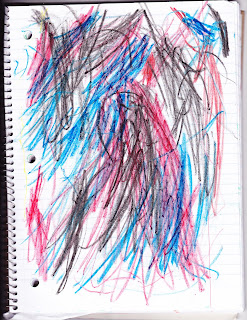As many first-time parents, I had several firm opinions about how I'd raise my child, and being playpen free was one of them. Not only did the baby books I loved disapprove, but some of my earliest memories involve being on the "freedom" side of a homemade play enclosure, built for a family member who was confined for medical reasons. My dad and I spent much of the 90 minute car ride home talking about playpens, gates, and play spaces. Ultimately, I heightened my awareness of times when Hadley was involved in her own play, forcing myself to sit back and watch instead of inserting myself into her games.
Now, watching my 4 year old twins develop and explore their language, I'm reminded of Lea's advice to take a step back and observe. Conor and Brady have a rich vocabulary, but their articulation needs work. They've both been evaluated and both are developmentally on target, they simply need more time. I repeat their words, modeling the proper pronunciation. We play sound games to help correct their speech. But I resist the temptation to jump in and disrupt their play, especially in the middle of their elaborate role playing and fantasy games.
Conor, especially, loves to make up stories when he draws. He spends long periods of time with one piece of paper, coloring with markers, crayons, pencils. He talks the whole time. By the end of each day, the floor under the art table is covered with paper scraps. They all look pretty much the same:
 Without seeing him in action, you'd think these are simply scribbles. You might comment on the waste of paper, the clean up, the marker on the floor, the broken crayons littering the table. But each and every one is a complex story, all of his own invention. This morning, I wrote down his words as he drew this:
Without seeing him in action, you'd think these are simply scribbles. You might comment on the waste of paper, the clean up, the marker on the floor, the broken crayons littering the table. But each and every one is a complex story, all of his own invention. This morning, I wrote down his words as he drew this:"Fire, fire! There's a fire! Call 9-1-1! The firefighters race to the building. We need trucks! Get hoses! A firefighter rushes to the scene. Emergency! Here's a fire chief. We need a ladder! Get the aerial ladder! It goes up and up and up to get the people. Hey! They are stuck on the roof. Get the helicopter to come and get them. Whirrrrrrrrr. Now they are gone. Water! Water! Whoosh, whoosh. The fire is out."
His words are proof that he retains stories that we read out loud together, the facts he has learned from books, the images that accompany the action. It's all there in his memory, and he's taking all that knowledge and making it his own, both on paper and with his voice. Sure, I could sit with him and draw a decent fire station, truck, burning building and rescue workers, something that we could later hang on the fridge and admire, but the dialogue wouldn't come close to what Conor accomplishes alone.
Kids need the space and time to talk it out, to link words and ideas together, to practice all those ideas they've overheard. Conor and I can sit down at any other time and spell his name, practice writing letters, color in pictures...but nothing is better than letting him loose with $5 worth of paper and art supplies.





No comments:
Post a Comment